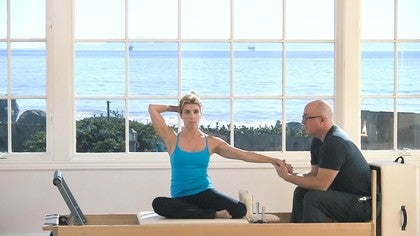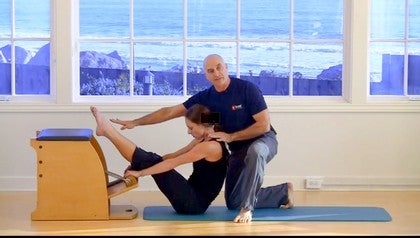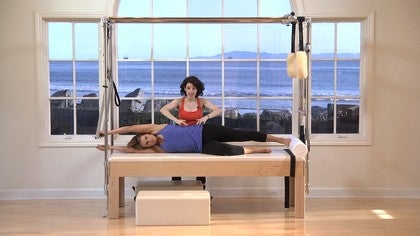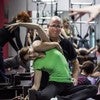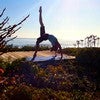Description
About This Video
Transcript
Read Full Transcript
My name's Doctor Brent Anderson and it's good to be back with Pilates Anytime and to be with Christie and we're going to go through a reformer class, and particularly one for a healthy spine. So let's get ready to go. We got two reds and one blue spring on here. I'm gonna ask Christie to start on her back and we're gonna start with some footwork. And one of the things that I really emphasize in footwork and as you sort of get ready to go here you can start, is just allowing the body to settle in to the exercise.
So allowing the body to fit into the machine, gravity take its effect, and even get the head into the exercise a little bit before I start making any corrections or giving too much feedback. Just sort of feel that length. So What I want to focus on from a healthy spine class, really is the process for us to get the disassociation in the hips. So just continue moving Christie, and I'm just gonna keep sort of giving you a little tactile cues. And keeping the ribcage in relationship to the pelvis.
So in footwork in particular, to me, the breath needs to be used as a tool, not the rule. I know a lot of times we teach Pilates, we tell them oh, you have to exhale when you push out or inhale when you come in, and then they sit up, and they hyperventilate, and they pass out because they've breathed too much. So just breathing naturally. If I see that her back starts to come up off the mat, I might use an exhalation at that time to keep that from happening, or that she's doing too much posterior tilting, I might use an inhalation for that. But this looks good.
Bring your feet together, and let's just continue with this process, so warming up nice and easy. And every time you press out, just feel a little bit more length happening, a little less pressure. The shoulders a little longer though the back to the neck. Just feeling that connection. Your toes look great, reaching up toward the ceiling.
And three more times. Then we'll go into a 45 degree first position. And go. And turn out just a little bit, about 45 degrees same thing, again, just warming up increasing the awareness. And one of the things that I like to focus on is to allow the ribcage to swell and to narrow.
Now I'm just following her breath, I don't really feel like it has to be at a certain time but just to feel that it does both. It's not just about holding it in, right? We gotta be able to expand. All muscles need to stretch as well as contract so they need to lengthen and shorten. Good.
Let's go with a little bit wider foot. Yep. And this time what I want you, I want you to think of moving from the sit bones not so much the legs. So you're down in this bone rhythm position here where the sit bones are wide, and to press out the sit bones are gonna narrow. And you come back down, you're gonna allow the sit bones to widen.
That's the movement, that's where I want it to come from. So the legs are just following and this is a chance for those of you that are familiar with any of the bone rhythms or from some of the other workshops we've done where you can really emphasize that feeling of the femur spiraling laterally and the pelvis spiraling medially on that movement and back out just the opposite. Very nice. Just lubricating those hips, warming them up lets take two more of those and we'll go right into some knee circles and just allow the heel to spin on the foot bar and again, I've got two reds and a blue spring for the warm up. Some people like to go even a little bit heavier that's fine, or maybe to go a little bit wider, that's fine.
And let's reverse that direction. Good. And if you feel a little bit of ratcheting going on in the hips, that's usually the muscles getting in the way, so try to allow it to smooth out even a little bit more and not have the stickiness to it. And come on down. Lets go down to the balls of the feet parallel and press out for me.
Stay there, let the heels drop down. And what I want you to do is feel as if your body is in a hammock stretched between two coconut trees. And it's actually the whole fascial plane on the back of your body is that fabric. So you feel as if I was grabbing the back of your head and the heels and just feel that length there for a second. Just appreciate that.
Now to return the carriage home, just bend the knees up toward the ceiling to bring the carriage back home leaving this reaching down and press back out through the heels. Bring the carriage home through the knees. That's it. Reaching out, sending those heels down, knees coming up, very good. Heels down, and knees up, good.
Let's do two more of those. And again, creating that line through the back of the body, not just an awareness of the front. It's not just about the abdominal muscles, it's about the whole body the cylindrical aspect of the body. Rise up onto your toes. Lets leave the heels high, and now bend the knees in a forced arch position, good.
And press back out. And typically by the time we get to this stage, we're into our exercises, aren't we? So the mind is already wrapped into focusing on our body and we're not thinking about lunch or dishes or jobs or taking care of kids or anything like that. All those things are out of our mind. Except I just brought them back into it.
(laughing) They were. And let's alternate, so press out drop heels down, raise heels up bring knees in, that's it. And out, heels down, heels up, knees in. Which is the same rhythm of the knee stretch when we're sitting down. So a lot of times, we learn those basic exercises here in footwork, you don't even realize they're built for the other exercise we're gonna do a little bit later on.
So let's go from here, let's go right into running feel the reciprocal movement going through the body and by this time the legs are awake and the body and the trunk are aware of its disassociation. And relax. So what I wanna do now is I want to take a look at you just on your heels again and we're gonna go into a bridging series and we're gonna look at just getting good mobility throughout the spine, okay? So warming the spine up. Just start simple bridging, rolling up I'm still two reds and one blue spring for the bridging series.
And again, the idea here is we don't want the carriage to move right now. So we're gonna allow that movement softening through the chest and down and remember that we're looking for a flexion in each of the vertebrae, so it doesn't matter if one drops down or one flexes up. What matters is if they actually articulate segmentally. So rolling up around my hand, around my thumb, good. Feel that length, good, taking a deep breath and this time give this one to me, just this one yeah, good, good, good, exactly.
All the way down one more time. And you wanna feel almost like if I drew a line a chalk line right where your sit bones came down to the mat, that every time you came down it'd be just another couple millimeters further away from your head, okay? So let's roll up, and let's do our favorite typewriter exercise. I'm not any better than I was last time. Sure you are, sure you are.
Come down just a little bit into my finger here, good. That's where we're gonna start. So I have my finger probably close to about T6, T7, and what I want Christie to feel here, is I want you to slide purely to the side, and feel that shift, there it is, good. Oh, wow. And then shift back to the other side and feel that shift, good.
So again, I'm blocking the upper, and facilitating the lower. Back again to center, and we're gonna drop down another segment, there. Good and then we're gonna slide. There we go, good. And then come back. Good.
And let's do that one again to the left. That's what I want you to find. Do it again to the left. There it is good. Drop down another segment.
And slide to the right, slide to the left. Good, and back, drop down another segment and slide, good. Here we go, good. And what happens is, you notice how it's easy to go to the right and the upper segment and the lower is easier to go to the left and that's typical, so if there's a little bit of a rotation, a little bit of scoliosis, tightness those kind of things, you'll often find opposites at different levels, okay? So that's very typical and finish down, good.
Now let's do one more thing, I'm gonna have you roll up into your bridge and I'm actually gonna have you move your hand out of the way there, because I'm gonna block you here, yeah. And what I want you to do now is you're gonna roll down through your spine. The middle? Yep. And just let that left hip go to the left let it roll down all the way down.
And just feel that hanging out of there a little bit, yep. Just gonna pop. And it might. It did It did, oh good. And then just bring the left hip back up segmentally, good, good, good.
Just to the neutral, and then drop back down. That's right, good, good. Let that open up, opening those fisettes beautiful. Come back up and I'm gonna slip over and do the same thing on the other side. Good.
Now you might have to use a block or those kind of things underneath depending on how tall or short somebody is. (laughing) Right? Let that right hip drop down, all the way down. There it is, there it is. Oh it wants to open up there, doesn't it?
And roll back up. And roll back down. Let that right side drop down around that axis. That's it and back up and back down we don't even have to go all the way up. Right there.
Go down? All the way down, mm-hmm. And relax come back up and drop all the way down. Now let's just take a look and see what your segmental movement looks like without me touching anything and just feel a much different sense of the segments you're gonna move now you're gonna get probably two or three more segments to move. Exactly already, good, good.
So a lot better segmental movement it's hard to pick up on camera, but you can see and feel Definitely Inside yourself the different couple segments, yep. Good, good, good, good. So now what we're gonna do is create a sense of control around those segments, okay? So let's bring the feet together, yep and let's roll up into your bridge. And then I'm gonna have you bring the sternum down just a tad so you're in a little bit of flexion in the upper back, perfect.
And then let's press out about halfway with your legs. And what I'm looking for is similar to like the Dolphin or the Magician, the hips are gonna stay open, and the movement is really gonna be in the knees, so when the knees come back in, the bottom's gonna rise up with it, okay so come back in and press back out and each time, try to see if you can go out a little bit further, maintaining that without losing that range. Good, good, good. And out. Good that's right.
Now what we're gonna do, is drop down two or three segments in your spine do the same thing. Just go the way you can go, yep. Come back in, drop down a couple of segments. So you're only gonna be able to press out about halfway. There you go, that's it.
Good, come back in, drop down another couple segments. A little more, right there, now press out. Now come back in, press back out halfway and this is where I wanna be, stay there. Now can you lift your right leg, just disengage right foot, just disengage, back down, good. Disengage left foot.
That's the hard one, good. That's the one I want you to work on. Right foot, come back in. Left foot. So all I'm doing is identifying where I know you're having your biggest challenge to stabilize that, and come back in all the way, and roll down.
Now you're gonna go back up when you catch your breath. (laughing) and we're gonna do that little lato translation to the left again, which I think you're gonna find it's a lot easier now, okay? So when you're ready, roll up. And it was about right there that you had the difficulty so now shift to the left, and see if you can keep it on the horizontal. There you go, yep, that's it.
Find it, good, good. And back. That's right. Yep. Just stay there, we just wanna work that level to get you used to being there.
Even there, can you lift up the right foot a little bit? Yep, back down. Can you lift up the left foot? Try, there you go, good and back down. A little of that makes you heat up, right?
Totally You feel the whole core working, yeah. (laughing) Good. And come back to center, good. Just shift back and forth of that level now it's gonna seem easier to shift to the left and to the right now, there you go, just nice and easy left and right. That's where you wanna find.
Find me over here. That's it, good. Now the reason for that, what we're doing is waking up those local muscles and telling the global muscles, the big muscles to chill out a little bit so that we're not so focused on them. And that's great. You can come on down, now that's great, yep.
Good. So we're gonna shift into some feet in straps I'm gonna take you down to one red, and one blue spring. And if you'll meet me at 45 degrees with those feet, Good, okay. So let's go parallel. And let's look for that connection now, just really disassociating at the hip, right?
Pelvis is gonna be dynamic so remember, as the feet come up, the pelvis has to actually do a relative extension. As the feet come down, it has to do a relative flexion both anterior and posterior muscles are gonna be working opposite, sort of like the sinusoidal wave going on in your body, okay? So we're gonna rap it out as efficient as possible legs float up, and down. The image I like to use here, is just a door opening and closing, and having springs on both sides. So gravity is the force pushing down, that's right.
Now give me a little more length through the upper there you go, good. I'm gonna have a seat right here. Now bring it down now let's separate the legs just a bit. Now bend the knees toward your chest and press right back out to me. Now with that being said, close your eyes and just notice the difference in the legs, bending in and pressing out.
And reaching back out to me. So is one leg doing more work than the other? Does one start earlier than the other? And this is often one of the problems that we get with pelvic torsion, so a lot of people coming in to us with asymmetries in their body. See if you can correct the asymmetry from the inside Christie, not from the outside.
So if you feel one leg working more, see if you can balance it out and work it less. If you feel one leg starting before the other, see if you can initiate the other leg earlier. That's right, good. Like they end and start at the same place. Excellent.
One more time. Now leave it out straight you're gonna bring the heels together and go right into frog. So bend the knees in, and lets do one stage of frog push back out, just the plie. That's right. And stay there, there's something I want to show you with this.
So we're gonna use a yoga block to be able to help open up the hips a little bit more. You're gonna feel the difference. So what we're gonna do is, go ahead and let the legs come up, and let this come underneath your sacrum there you go, good, exactly, good. And I want you to reach the legs down but I still want you feeling like your low back is reaching for the mat a little bit, yep. So right here, I'm gonna have you open and close the small range, just like that, yep, you got it.
And I want you to continue reaching this down into my, yeah, there you go, good. Now, two more at that height, and then bring it down a little bit lower. Same thing, go. This is a little trick I learned from another Christie. Yeah?
Christie Idaroy. Oh, yeah. Yep. And bring it out a little bit lower and open and close, there you go. There you go, now we're struggling.
Now we're hitting that point that I wanna be at. Bring it down a little bit lower, keep going small, little pulses. Oh this is gonna feel so good to you when I take the block out. (laughing) Sure And a little bit lower. Now just go through a up and down, just a little range of motion, the feet in straps and see how low you can take it down arcing through this space, not the lower back space, yes.
Good and up, and press down, so this will open your hips yes, good, good, good, good. You're gonna stand up and feel so good when this is done. And relax. Beautiful, let it come up. I'm gonna slip this out, but I want you to notice the difference in your range of motion now, just do a regular feet in strap arc, yeah, and just notice how low you can go without any challenge.
Can you feel the difference in that range? Yes. Good. That looks better there, good. You're gonna feel much better standing up with that.
Because we don't realize how functionally shortened our hip flexors are throughout the day I mean we're always sitting, and we're not in typically, or bent over somebody, and we're not when we stand up, we don't realize how much stress that is on our back when our hips can't open up. Good, alright. Let's finish up with just a couple circles to keep the hip nice and open so up and out and around, let's stay parallel with it so we get that little bit of a stretch in the posterior fibers of the hip, there you go, good. And the same thing applies here. If you wanted to do all of your feet in strap work over the block?
Yeah. You could do all of that, and you would be opening up all of those anterior fibers and groin fibers in that position. Sure. It's one of our problems sometimes, I know Darryl Essen talks about this sometimes too is that we don't get our feet down low enough to be really functional, I think it's important that we integrate that. Yep, there you go.
Excellent, and relax, good. Let's bend your knees, and let's take the straps off your feet, and we're gonna use them with your hands. I do wanna adjust the springs just a little bit. So I'm gonna go with a red and a yellow spring for some arm arcs, okay? So let's keep the legs at a 90, 90 space between the shoulders and the pads, that looks good.
And let's just see your arm arcs here, so bringing it down, and again, this is just not challenging the upper body, I wanna see this relationship now continue to be the same, even though we're working through the arms and the shoulders. Exactly. Notice, I only want the arms to go down far enough but I don't want that shoulder to pop up or come forward. Yep, there you go, good. That's it, so you feel like the collarbones are widening as you go lower.
There it is, good. Widen, widen, widen. And this is preparatory for what exercise in kneeling? In kneeling? Mm-hmm.
Chest expansion. Oh. Alright? So we're learning how to get that nice and wide feeling across the shoulders the first thing they'll do is they'll collapse when you do a chest expansion. Good, alright now leave it down bend the elbows, and let's go right into some coordination.
So you're gonna roll head and shoulders up, reach out with the legs, a little beat bend the knees in, bend the elbows in and repeat. Let's just do four of those and out, and beat, and knees in, elbows in and reach and beat, and knees in, elbows in one more time, beat and in and relax. Very good, alright. So we're gonna move into a different territory here, I'm gonna have you come up on to hands and knees, and we're gonna go into a quadruped position for knee stretch. And we're gonna start with a round back and I'm gonna start you with a red and a blue spring here we go.
So in the round back, what I wanna focus on is still that axial length. So this is where the hinge is gonna be in the front of the hips, so this is gonna stay in this relationship as you press out and come in. Let's try it with a couple of slow repetitions press out, and accent in, and out and accent in, that's it, alright? So we're not hinging in the back that's the most common mistake with knee stretch is we get a little carried away and wanna do it fast and hard, and we end up moving from the back that's right. And now we're gonna transition into a flat back or a neutral spine, good, same idea here still hinging from the hips, and in, and in, good and in, if we wanted to make it advanced, we could go knees off, we're not going to do that today.
Christie just went whew, we don't have to do knees off. I did. Good, now come all the way in, just bring the hips straight forward from here we're gonna transition into down stretch. Good. So again, you're gonna feel more open here in the front because of what we did with the blocks.
So let's take it out. Does that feel too hard on the shoulders with the red and the blue? You okay? Mm-hmm. Sometimes you might have to lighten the spring a little bit if you're going just for the arms.
Christie's so strong, it's okay though. Ha ha. You do Pilates for a living? I used to. Good.
Now here, feel that length, and I wanna see a little more, yes and think of the ribs gonna go forward, and down as you continue to go up with the head. Ribs go forward, and down, yes good, good, good, good. One more time ribs are gonna go forward, and down. Lengthen up front, that looks great. And lets come right up into elephant from here.
I still have her on a red and a blue and we're gonna go back to the same concept we did for the knee stretch, so she's just gonna press back and then she's gonna accent coming in with the exhalation, that's right. Give me a little more space, there we go, good. I love how her head is just resting in its position away from the spine, it's in alignment with the spine. It's not cocked up, looking forward, or chin to chest she's keeping that space. Now from here, let's try to go a little bit into a flat back or a neutral spine elephant and just see what that feels like, same thing, good.
So this is gonna be a little bit more of control the pelvis, a little more hamstring, good. And from here, let's go ahead and let those heels rise up and we'll just do a couple plank versions. Now this, when you push onto plank, do let the head come forward over the foot bar. So it's not like you're trying to push up plank and shoulder extensions, that's right, good. And hinge back up, and press out.
Good, and back up, conscious of those hips, where's the movement at, good. Now stay there, and feel the difference between a deep inhalation, exhalation a lot of times people are saying oh, you have to exhale when you're in this position, you have to inhale. The truth is, you gotta be able to do both. So this is sort of that static pose for like 10 seconds, I like people to do there's nothing static about it, there's a lot of energy going on here. And from here now, let's go right into Jackrabbit.
So let the knees bend in, and press back out, and in just four or five repetitions typically, is enough to be able to find that, and the last thing we'll do, is long stretch, four or five repetitions so we're just teaching that body, that's right. And with my back patients, I like to keep my hand on those lower ribs, for that case that they do fatigue and they buckle, that's the time I'm there to protect them. Last one, and let your knees come down, and relax, good. Excellent. Doing good.
Feels good. Alright, let's have you sit on top of the foot bar. I'm still at a red and a blue spring, and we're gonna stay there. We're gonna do a little knee extensions, so you're just gonna hook your heels onto the edge of the carriage finding your balance, and just press the carriage out and we'll see if I need to come down a little bit for you you're tiny, you might need a red and a yellow. Can I hook my sit bones?
You can. Okay. But I'm gonna give you a red and a yellow still. Okay. So I'm changing to a red and a yellow from a red and a blue, and that just merely has to do with weight.
So let's find the balance, you're talking about hooking your sit bones should be just a little bit in front of the bar so the springs wedge you into the bar. Not push you over the top, and also don't let you fall into the crevice, okay? So bend your knees a couple times, and just see if you can find that balance on there without your hands. You'll find it. It's always, I love this exercise because it seems really hard, but when you sort of find it, they are really proud of themselves, a lot of the patients with low back pain, that they can actually do this exercise.
And it's a true disassociation exercise of the upper back, because now what's gonna happen is we're gonna take your arms into a second position, keep the legs going, and as you press out, you're gonna sweep down and forward, as the knees bend in, you're gonna come up lift chest up tall, go into extension, of the arms, and press back out into flexion. Keeping that balance. So the spine, the upper spine is moving into extension and flexion while she's moving through the legs catch up with your upper body for a second. Let the legs stand, and come up with your upper body. Yeah, there it is, good.
And extend, and press out and sweep. Arms come up, knees come in. And sweep back out, and up, good. And from here, we can add a little bit of rotation to it, so it's gonna go, just follow me, like we're dancing press out the same, we're gonna lead with a right arm knee comes in, there. Come back into second, sweep out lead with the left arm this time out to the left side, good and sweep, and the right side, good.
And turn, and sweep, and left, excellent and relax, good. Going right from there, just working on our transitions we're gonna go right into a high kneeling facing this direction, yep. And we're gonna grab the straps and I'm gonna leave you at a red and a yellow. It's a good one for you. We're gonna go into a pre-chest expansion if you'd like to choke up on there you want a little more range, or if you're comfortable holding in the strap, either one is fine with me.
Good, that's what I would choose too. And angle back just a smidge at the knees, good in the chest expansion, what I want you to focus on is more getting the lungs to expand in all three planes. Right? So the challenge for us typically, is we will do an inhale this way, and push back like a military position. That's not really what I want.
I want you inhaling, and just bringing the arms out to the side. So I don't care how far back the hands go, I care that we're wide and the air fills out and then when you're gonna exhale slowly looking to the sides and then releasing and continuing to grow as the hands go back out you're getting narrower and taller and you're gonna really wanna inhale when you push back in. By that time. Yep. Okay.
Okay, good. So blow that air out to start, good. Inhale pressing back. Good, exhale looking to the right, to the left. And slowly forward, all the air out all of it out, out, out, out.
Good, and inhale good, you're ready for that. And exhale to the left this time, right and forward slowly with the straps get rid of all that air, all that air out, out, out, expand back here this time in the inhale that's it good Christie good, good, good, good looking to the right, to the left and slowly out, one more time even more this time to the back feel the expansion all the way around. Yes, yes, yes, yes, yes, good. Left, I just felt those ribs open up on the right that was good. And relax, good.
So again, you don't have to do a whole lot of repetitions of it, four repetitions, but really concentrate on where that air is going in, or not going in. Okay, good. So let's drop this, and go into a quadruped. I'm bringing the springs down to one blue. And let's get a perfect square give me about three or four inches, there we go, good between you and the shoulder pad.
Yep. Hands directly underneath, thumbs are out of the path, good. Now just lean forward to make a parallelogram, yep. Ribs are connected, and just approximate the carriage to the hands, just moving from the hips so the knees are gonna pull in, you got it right there, and back out. And back in, that's it, keep this control where my hands are, my hands are telling her to control those ribs, mm-hmm.
That allow her really to be stable through that area and draw upon those hip flexors. Here's a good lesson. The hip flexors attach up this high in your back in the front, that's right. So this drops down, you put your hip flexors at a disadvantage right? So by keeping this, now those hip flexors can work.
I can actually increase the weight and you could handle it, where you wouldn't be able to do it if you didn't have that connection. Last one, and relax, very good, excellent. Excellent, good, excellent. Come on off from there. And we are gonna use our box today and I'm gonna have you just sit up on top of that box.
We have all of our springs on now for safety. And we're gonna bring that foot strap up. So on this one, arms across the chest. Lean back? Just right where you are is good.
Okay. Good so what we're gonna do is that idea of the little inner tubes in between your discs, okay? Mm-hmm. So let's get that image here, of just pumping up those discs. (hissing) Now, what we're gonna do is, without losing height, roll the pelvis back as far as you can without losing height.
A little bit of a posterior tilt to the pelvis go as far as you can. Keep rolling it back, the pelvis back, yep. And stop good, come back up. So what happens is the lumbar curve is here and the pelvis is underneath it. When the pelvis rolls back, you lose height but the lumbar goes into a little bit of flexion you gain height.
So that's the preparation before you go into flexion posteriorly, alright? Okay. So if you think of it you have wheels on your sit bones, and you're just rolling that back without losing any height, prepares you now to go back into your abdominal work on the box. Yes, so keep coming back, good. I like that, and you can keep coming back into my hand, and then you're gonna come up from there.
And we'll start there, good. All the way up nice and tall, find those inner tubes, good. And then rolling the pelvis back away, good. So now it's really much more of a soft tissue articulation going on there, than putting pressure on the vertebrae. One more time.
That's right, that's right. Now you notice you're working a little bit harder too, right? Yeah. Good, and come back up. Now in this one, we're gonna go with a little bit of a diagonal.
Okay so in diagonal, we're gonna go with a little bit of a rotation, but I still need you to stay on your axis. So same idea, rolling that back, and coming down, mm-hmm. Good, and same thing coming back up, up and around, up tall into that position, rotate towards me. Same thing, hollowing underneath, coming down stay on your axis, good, and back up, good. And and tall, one more to the left and as far as I'm concerned, you can feel free to breathe in or out, just send your air in the right place.
If you send your air three dimensionally like we practiced in chest expansion, it's gonna help you in your roll down. And expand in here. Mm-hmm, and then exhale coming back up from underneath here. Yep, good, good, good. Alright, nice.
Now take your hands up over your head. Yep, just like that. So what you're gonna do is you're gonna roll down as if you have the dial and bring your hands down to your thighs as you roll back. So hands will come down to your thighs. Good, now come back up, hands will come back up, yep, come up tall with it.
Yep, now this time same thing, come down go down to where you feel comfortable I would not go as far as last time because now I'm gonna have you bring arms up over the head, yep, bring hands back down to the thighs, and now everything comes up, arms and body, good. Let's do that one more time. Exhale, roll down, hands to the thighs, body stays there, hands come up, hands come down, and everything comes up. And turn sideways facing the back of the room. Bring your left leg out, yep.
And let's bring both hands behind your head. Actually let's just bring right hand behind your head, yep. You're gonna hang on that. And let's put this hand down on the pad there, okay? So this is one, just where we introduce it the idea of lateral flexion to our clients with some low back issues.
So what I'm gonna do is I'm gonna assist you now that you're in that position and you know if you ever get concerned, you can put your hand down and you're safe right, the left hand. Mm-hmm. So now bring that left hand up to your head and I got the control of that, okay? So we're gonna keep the ribs in alignment, and we're just gonna drop down an inch and come back up, and down, and back up, that's right, good. And down, so we don't have to really go too far down to get the benefit of this exercise.
One more repetition, and then we change sides. Just four repetitions is plenty. And all the way up, switch sides. So again, the assisting gets rid of the fear of dropping off the cliff there. So again, the hand there, hands behind your head yep, good, and when you feel safe there, you can bring that right hand up, and we're going to drop it down, and bring it up concentrate on coming up, that's it good.
And coming up, good. And coming up, good, last one. And relax. Excellent, good. Let's come on off of there, and let's go right into a long box just for a little bit of extension.
Because we haven't really hit any extension yet, and I like to be able to get a little bit of everything in. Let's put that right there. Okay, now we're gonna go down to the springs to just a single red spring. And I'll have you mount onto the box from the back your chest will be just off here. Your mouth just over the bar, but don't lick the bar.
I promise. You get a fungus, it could be lethal, alright. So from here, let's just start with an overhead press to begin with, but notice the direction of my hand, good. So overhead press, and press out, good. Do three with the elbows going out, and then you're gonna bring the elbows down.
Yep. Good, now this time, press out and stay out and we're gonna let the shoulders and the neck and head peel off as you come in with arms straight so you're coming up into a swan, ribs are coming in and down, good. And press back out, good. And in and up, feel it coming down this is that movement we want in that upper back of yours. Yep.
And out, one more time. And in and up, feel that connection, you got it, you got it, good, good, good and relax, good, good. Let's come on off of there, let yourself come in nice and easy. And off you go. And we're gonna finish up with a little bit of Mermaid just as a relaxation, get some stretching all the way around the spine, so go ahead and assume that position, facing the back of the room.
I have you on one red spring, and that's plenty. I'm gonna do something a little different, okay? So you do the same thing, but I'm gonna come over on this side, and I'm gonna be your bar so I want your left hand, you got it. And do me a favor, take that down just to a yellow spring. So we're gonna go with a yellow spring and go the opposite direction.
I want the legs exactly how they are a lot of people wanna change that. Put your right hand behind your head and now allow the carriage to slide to the right. Reach that right elbow up to the ceiling, yep. Breathe into the right lung, yep. And then exhale, pull the carriage back toward me making yourself more upright.
Good, and again. Keep the ribs, yep, good. And pull it toward me, good. So you're actually using those intercostal muscles on the other side where you can now contract them and relax them, so I like the flexibility in that upper thoracic, good. This time, come over toward me and roll down towards the mat, and give me your right hand.
There we go, good. Now push down into my hands a little bit, and lift your chest up, pushing down, pushing down, reach with me, there we go, good. And then press back into me. Let the carriage take you back and stretch that area, yep. Now stay there for a second Christie, just breathe in between your shoulder blades, yep.
Feel that expansion, that's what I want. Now when you're coming back up, you can press down into my hands and go into extension again. Push, push, push, move the carriage toward me a little bit, good, that's it. Now leave the carriage here, go back into your flexion but don't let the carriage move. So now, all the works coming inside of your Christie, it's not the carriage.
This is really important, really powerful. Come back up into extension, you only need to do one or two of these. Yep, yep, yep, yep, yep, good. Keeping that carriage quiet, you're doing great go back into flexion, keep the carriage there, you got it, you got it, good. And back up into extension, excellent, good.
Let's open you up, and we're gonna switch sides. This will be great to see from the back. How's that feel? I might start crying after I'm done. It feels good, it feels very good.
A good cry, or a bad cry? A releasing cry. Well, a good cry would not be on camera. (laughing) It'd be very good. Left hand behind your head.
You know, it's good to show the effect of Pilates on every aspect of our being. Yeah, I am being. Alright, so right now, we are gonna reach that left elbow up to the ceiling, let the carriage go to the left and stretch the intercostals on the left and then recruit those muscles, reaching that left elbow up to the left side of the room, and stacking yourself back up, yep. Just like that, and give me a little more depression with that right shoulder, yep, here we go. Inhale on that left rib, left lung expand, expand and then stack back up, reaching that left elbow, yeah, yeah, yeah, there it is.
Move the carriage, good and again. Oh, I'm so happy that we're getting this on video footage so people can see this. And up, not the crying thing, but the (laughing) good, now this time come up and over and bring me that left hand of yours. You got it, there it is, working through that space, be patient in there Christie, don't force it don't force it, just some breathing. And whenever you're ready, you're gonna pull up into extension, so push down into my hands, lift the chest up, the carriage can move a little bit, keep lifting up with it, yep good.
And then let the carriage go back and take you into a little bit of flexion, you got it. And again, come in and lift up with it, you got it, that's it, now leave the carriage there, leave the carriage there, work inside, it's all inside right now. There it is, there it is, beautiful. And then bring it back up into extension, staying right there with that carriage. Good awareness, that's it, that's it, you got it, one more time.
And flexion. I'm afraid if we do two more of these, I'll start crying. (laughing) and up, up, up, up, up, up. Bring it up, bring it up, you got it, feel that expansion in those ribs, opening back up, yes. And open up to the side, and release.
Very well done. Thank you, you're welcome. That was great Anything you wanna share with the camera, what you feel? Sure. I can come sit next to you so they can hear the mic.
Oh, good idea. Yeah, well, what I wanna say is the obvious part of it, is I've been sick, recently I've been very contracted in my lungs so it's a little scary at first, and then it's open and it's free, and that happens to be what I'm trying to do with my life so they're connected in that way, and then I get quivery and open because I'm not used to this. Good, good. So it feels good. I have to apologize to the camera a little bit because I said I was gonna do low back class but I always teach to the person so the things that I saw were things that Christie needed, not necessarily maybe what they needed, I hope you benefit from it, but the idea is that we follow through and start looking at what was moving, what's not moving, where tension is, where tension is not, and to follow that pattern to see what you were doing and so it was nice for me to sort of see that unveil itself, to see it, and watch you open up and experience that movement.
And even coming from the physiology of the pleuricy where that's the lining of the lungs, it's what connects to the rib cage, it's what is responsible for creating the tension for breath to happen. So one of the problems of pleuricy, is if it doesn't get treated, it scars down like anything, it's an inflammation, and inflammation causes scarring, scarring can cause restriction which means people lose their range of motion in their rib cage because of pleuricy. Yeah. So the importance right now is for you to really as your rehabbing this, is to just really focus on thoracic mobility, and breath, and everything else is secondary to that right now. And then you already had some restriction there to begin with, so this is a good chance for you to say, wow, I can really do better and to realize that you can do better.
yeah, there's questions around even getting that kind of an illness you know, because I am normally restricted there anyway, and I just felt movement so close to when I was really not moving at all it's exciting. Good. Everything can change. Good, everything can change. We are dynamic creatures.
This is Dr. Brent Anderson, it's been a pleasure being with you on Pilates Anytime I look forward to seeing you in the future. Thank you, Christie. Thank you very much.
Back Care: Workouts and Tips for a Healthy Spine
Comments
I am so grateful to you both!!!
You need to be a subscriber to post a comment.
Please Log In or Create an Account to start your free trial.
